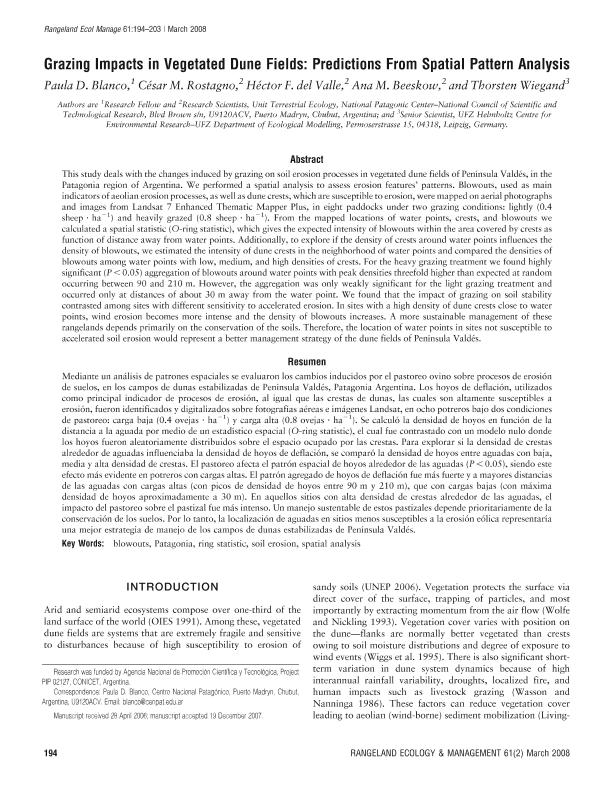Artículo
Mediante un análisis de patrones espaciales se evaluaron los cambios inducidos por el pastoreo ovino sobre procesos de erosión de suelos, en los campos de dunas estabilizadas de Península Valdés, Patagonia Argentina. Los hoyos de deflación, utilizados como principal indicador de procesos de erosión, al igual que las crestas de dunas, las cuales son altamente susceptibles a erosión, fueron identificados y digitalizados sobre fotografías aéreas e imágenes Landsat, en ocho potreros bajo dos condiciones de pastoreo: carga baja (0.4 ovejas · ha−1) y carga alta (0.8 ovejas · ha−1). Se calculó la densidad de hoyos en función de la distancia a la aguada por medio de un estadístico espacial (O-ring statistic), el cual fue contrastado con un modelo nulo donde los hoyos fueron aleatoriamente distribuidos sobre el espacio ocupado por las crestas. Para explorar si la densidad de crestas alrededor de aguadas influenciaba la densidad de hoyos de deflación, se comparó la densidad de hoyos entre aguadas con baja, media y alta densidad de crestas. El pastoreo afecta el patrón espacial de hoyos alrededor de las aguadas (P < 0.05), siendo este efecto más evidente en potreros con cargas altas. El patrón agregado de hoyos de deflación fue más fuerte y a mayores distancias de las aguadas con cargas altas (con picos de densidad de hoyos entre 90 m y 210 m), que con cargas bajas (con máxima densidad de hoyos aproximadamente a 30 m). En aquellos sitios con alta densidad de crestas alrededor de las aguadas, el impacto del pastoreo sobre el pastizal fue más intenso. Un manejo sustentable de estos pastizales depende prioritariamente de la conservación de los suelos. Por lo tanto, la localización de aguadas en sitios menos susceptibles a la erosión eólica representaría una mejor estrategia de manejo de los campos de dunas estabilizadas de Península Valdés. This study deals with the changes induced by grazing on soil erosion processes in vegetated dune fields of Península Valdés, in the Patagonia region of Argentina. We performed a spatial analysis to assess erosion features' patterns. Blowouts, used as main indicators of aeolian erosion processes, as well as dune crests, which are susceptible to erosion, were mapped on aerial photographs and images from Landsat 7 Enhanced Thematic Mapper Plus, in eight paddocks under two grazing conditions: lightly (0.4 sheep·ha-1) and heavily grazed (0.8 sheep·ha -1). From the mapped locations of water points, crests, and blowouts we calculated a spatial statistic (O-ring statistic), which gives the expected intensity of blowouts within the area covered by crests as function of distance away from water points. Additionally, to explore if the density of crests around water points influences the density of blowouts, we estimated the intensity of dune crests in the neighborhood of water points and compared the densities of blowouts among water points with low, medium, and high densities of crests. For the heavy grazing treatment we found highly significant (P < 0.05) aggregation of blowouts around water points with peak densities threefold higher than expected at random occurring between 90 and 210 m. However, the aggregation was only weakly significant for the light grazing treatment and occurred only at distances of about 30 m away from the water point. We found that the impact of grazing on soil stability contrasted among sites with different sensitivity to accelerated erosion. In sites with a high density of dune crests close to water points, wind erosion becomes more intense and the density of blowouts increases. A more sustainable management of these rangelands depends primarily on the conservation of the soils. Therefore, the location of water points in sites not susceptible to accelerated soil erosion would represent a better management strategy of the dune fields of Península Valdés.
Grazing impacts in vegetated dune fields: Predictions from spatial pattern analysis
Blanco, Paula Daniela ; Rostagno, Cesar Mario
; Rostagno, Cesar Mario ; del Valle, Hector Francisco
; del Valle, Hector Francisco ; Beeskow, Ana Maria
; Beeskow, Ana Maria ; Wiegand, Thorsten
; Wiegand, Thorsten
 ; Rostagno, Cesar Mario
; Rostagno, Cesar Mario ; del Valle, Hector Francisco
; del Valle, Hector Francisco ; Beeskow, Ana Maria
; Beeskow, Ana Maria ; Wiegand, Thorsten
; Wiegand, Thorsten
Fecha de publicación:
03/2008
Editorial:
Society for Range Management
Revista:
Rangeland Ecology and Management
ISSN:
1550-7424
Idioma:
Inglés
Tipo de recurso:
Artículo publicado
Clasificación temática:
Resumen
Palabras clave:
BLOWOUTS
,
PATAGONIA
,
RING STATISTIC
,
SOIL EROSION
,
SPATIAL ANALYSIS
Archivos asociados
Licencia
Identificadores
Colecciones
Articulos(CCT-CENPAT)
Articulos de CTRO.CIENTIFICO TECNOL.CONICET - CENPAT
Articulos de CTRO.CIENTIFICO TECNOL.CONICET - CENPAT
Citación
Blanco, Paula Daniela; Rostagno, Cesar Mario; del Valle, Hector Francisco; Beeskow, Ana Maria; Wiegand, Thorsten; Grazing impacts in vegetated dune fields: Predictions from spatial pattern analysis; Society for Range Management; Rangeland Ecology and Management; 61; 2; 3-2008; 194-203
Compartir
Altmétricas



